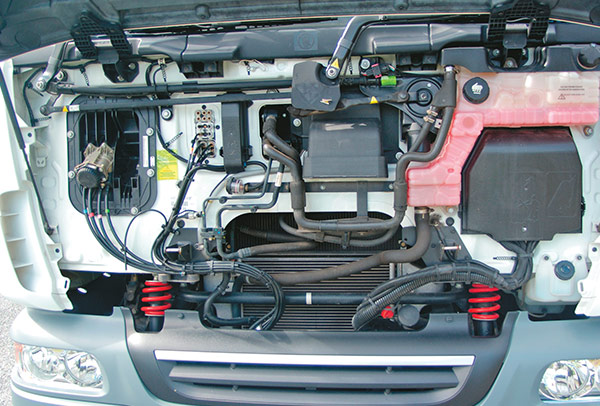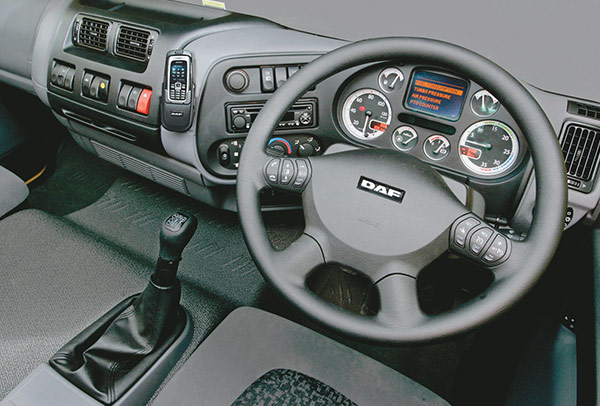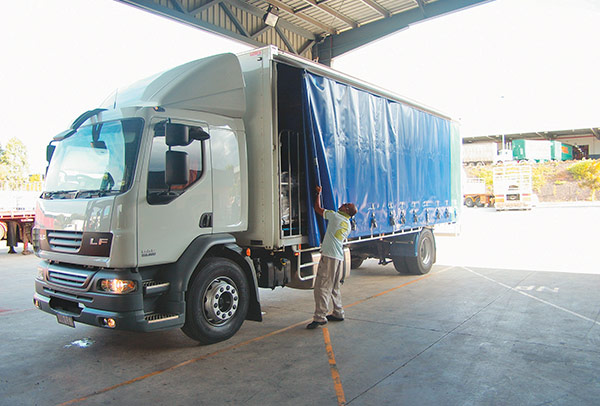In Europe the DAF LF 4x2 range is a top seller, yet in Australia the brand struggles. So why do the antipodeans love them so much? Gary Worrall tests the new model
When it comes to highly competitive market segments, the heavy end of the 4×2 market is possibly the most congested. Just about every manufacturer has a truck in the mix.
This can be confusing, but with such a diversity of product to choose from it means, whatever your preference, there is a truck that will be perfect for your needs.
DAF — the Dutch-designed, UK-assembled, US-owned truck manufacturer — is perhaps one of the lesser known brands operating in this segment.
Believe it or not, despite being an almost invisible brand here, in Europe DAF is one of the most popular and is very heavily represented in road transport.
Why is it so?
It is hard to say, especially after driving one. There is a lot to commend, and very little to say against it; the DAF tested offers a mix of technology and practicality as well a big serve of comfort.
From the outside, the DAF LF 55 is almost non-descript and perhaps that is its biggest problem. Unlike its American cousins it follows traditional European design trends, with a cabover configuration, and at a glance it is difficult to distinguish it from many of the similar designs roaming the roads.
It offers plenty of clues to its parentage, with a slight rearward rake to the screen while the cab corners are all rounded as if polished. There’s ducting at either side of the engine cover, smoothing airflow around the cab and reducing its effort in pushing itself through the atmosphere.
A cabover needs thoughtful design work on driver access for daily checks; the LF passes with flying colours. The access flap is placed so that standing on the ground the driver can inspect fluid levels, while there is also a handy indicator on the air filter showing how full it is.
The test truck is actually already in service on local work in Brisbane with owner-operator Mohammed Faiz. It is fitted with a roof-mounted air deflector to further ease the truck’s forward progress and it is matched to the All Truck Bodies curtain-sider setup.
The next revelation comes when you open the door. For a 4×2 this is a big truck, with plenty of space.
The door opens to a full 90 degrees which means even the biggest frames can get into the opening, and then use the well-paced hand rails and two steps to climb up, all the time feeling safe and secure.
Indeed, the whole truck exudes solidity: doors close with a cosseting thud, rather than a tinny clang.
Engine
The LF 55 is powered by DAF’s GR 6.7-litre in-line six-cylinder engine, fitted with selective catalytic reduction (SCR) to comply with Euro 4 exhaust emission regulations.
Transmission
Mohammed’s truck uses a six-speed ZF automated-manual transmission (AMT), rather than the full manual also available in this model.
Cab and Controls
Slipping behind the wheel you’ll find the LF is fitted with an Isringhausen air-suspension seat, with integrated seatbelt. While the Isri seats are becoming more widespread in the heavier categories, it is good to find them in the medium segment as well. The seat provides good support across the back, thighs and shoulders.
This might sound like a luxury, but in reality the driver of a body truck will be climbing in and out of the truck all day — a comfortable and supportive seat is a need, not a want.
After adjusting the seat for height, reach and angle, it is time to do the same with the steering wheel: just lift the lever, position the wheel so it is comfortable and then lock it back into place.
The wheel itself is a nice wide-diameter unit. It has plenty of padding to make it comfortable to use all day. Its four-spoke design gives it a sporty appearance — not bad for an 18-tonne truck.
The spokes are set low in the rim so there is a clear view of the instrument panel, which is dominated by large and easy-to-read speedo and tacho. Both have digital displays for trip meter, odometer, time and outside temp.
Flanking these are smaller, but still clear, gauges for fuel, water temperature, AdBlue level and air-brake pressure. There is also a larger display for warning lights and messages from the onboard computer management system.
On the steering wheel itself the button for cruise control is on the right, while the left side sports built-in Bluetooth controls and a single on-off button for the exhaust brake.
Located to the left of the driver are the AM/FM/CD stereo and the air-conditioning units. The controls on it are large and simple to find and operate without taking your eyes off the road.
Interestingly, in the storage unit above the driver’s head is a factory-fitted VDO tachograph, even though they are not used in Australia.
If there is one trademark design feature of European trucks, and particularly cabovers like this one, it is the number of mirrors fitted. In the case of the LF there are six in total: a pair of regular rear-view mirrors, plus rear-facing blind spot mirrors (as found on most trucks) as well as a downward-facing mirror on the kerbside for parallel parking and a similar unit mounted on the front of the cab for frontal parking.
This is not a truck for the superstitious — with a potential 42 years of bad luck if you have an off day, although with that many mirrors it really should not be a concern.
In fact, it is the mirrors that give rise to one of the few complaints about the DAF. The remote control is tucked away under the driver’s armrest on the door and can be difficult to reach for minor adjustments. It would be better placed on top of the armrest, near the controls for the power windows.
Perhaps not surprisingly, given the number of mirrors, the driver’s field of view is generally excellent, with clear sight lines around the truck. I did, however, have one incident of ‘losing’ an approaching car on a roundabout: it suddenly appeared between the two door-mirrors. A quick dab of the brakes allowed it to pass safely.
Performance
The GR fires up with a muted grumble that shows how much work designers have done to smooth out the engine’s performance and insulate occupants from outside noise. It is a pleasant workspace.
Selecting a gear is done by turning the rotary dial to either Reverse or Drive, and then releasing the park brake while bringing the revs up just as you would in a manual truck.
From there the computer takes care of the hard work, seamlessly shifting through the gears to keep the engine performing at its best.
For those who have not had the opportunity to sample an AMT gearbox, the ZF unit is a great advertisement for computer-controlled shifting.
Fitted with a twin-plate clutch, the gearbox computer takes its lead from the engine management system, and can change the non-synchro smoothly and accurately in a fraction of a second. The driver doesn’t need to lift off the accelerator.
Even more impressive is the AMT’s performance on downshifts. It is like sitting alongside a master driver who never misses a shift, with immaculate blipping of the throttle to match engine and gear speeds.
The road test was carried out on Mohammed’s regular daily route, with regular stops to pick up and drop off freight. The route included roundabouts, hill starts, reversing into docks and every other pitfall in the life of a route delivery truck. It performed flawlessly, regardless of the constantly changing weight of the truck.
That said, it also showed the one weakness of all AMTs: stop-start traffic. The AMT is essentially a racing-style sequential gearbox, just like a V8 Supercar or Le Mans sports racer, which means it cannot skip gears on downshifts.
This means the driver cannot roll up to the next stoppage in third or fourth and then skip a gear if the traffic begins to move. Instead the computer must work down to the required gear with a couple of quick downshifts, before starting to accelerate away again.
The upside of this is an aural treat for the driver, who gets to hear a series of exquisitely executed rapid fire downshifts before resuming forward motion.
But the downside is definitely hill starts. Because the gearbox uses a computer-controlled clutch rather than a torque converter, stopping on anything more than a two-degree slope makes the park brake mandatory to prevent burning out the clutch.
Other brands have overcome this by fitting a hill-start program. DAF could do well to investigate a similar offering on this truck.
The power steering on the LF is well-weighted, with plenty of road feel back through the wheel without being tiresome. Assistance at low speeds is excellent, allowing the driver to swing in and out of tight spots. The steering firms up at higher speeds to prevent the truck ‘floating’ between lanes.
Also impressive is the ride from the airbag suspension. It ensures load integrity regardless of the state of the road surface.
Despite traversing some of Brisbane’s worst and most corrugated roads in the Wacol and Darra area the freight was not disturbed, nor were driver or passenger.
Stopping ability is another plus. The LF is fitted standard with all-wheel discs, which do a great job of pulling it up under all conditions.
Although initially heavy, the brakes offer plenty of bite and feel, even through the air pressure, allowing the driver to judge the amount of pressure required.
Verdict
Overall, the LF is an impressive truck offering high levels of operator comfort, including a sleeper cab, combined with good serviceability.
It’s well suited to the task of pick-up and delivery work — as much to the Australian market as any other.
Specifications
Make/Model: DAF LF 55
Engine: DAF GR 6.7-litre in-line six-cylinder, four valves per cylinder; selective catalytic reduction (SCR) emission control with AdBlue; Euro 4 certified
Power/Torque: 210kW @ 2,100-2,500rpm / 1,050Nm @ 1,200-1,800rpm
Transmission: ZF six-speed AS-tronic computer-controlled automated-manual transmission
Tare: 5,150kg
GVM/GCM: 18,000kg/28,000kg






